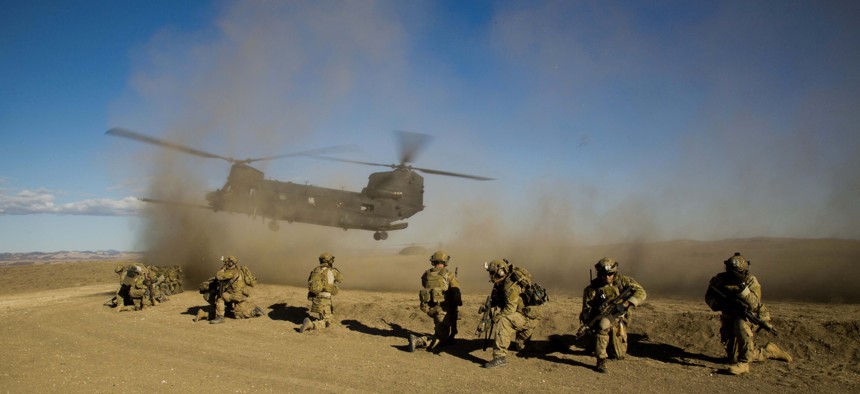
U.S. Army Rangers assigned to the 2nd Battalion, 75th Ranger Regiment prepare for extraction on a CH-47 Chinook helicopter aircraft during task force training at Camp Roberts, Calif., Feb. 1, 2014. DoD photo by Spc. Steven Hitchcock
No Turning Back? First Woman Makes Army’s Elite 75th Ranger Regiment, Big Step For Women in Combat
One woman just made it that much harder for anyone to argue women don't belong in America's most elite combat positions.
History has been made.
The U.S. Army’s 75th Ranger Regiment has become the first special operations unit to have a woman meet the standards of its selection course. Last month a female officer completed Ranger Assessment and Selection Program 2, or RASP 2, earning the right to don the prized Ranger scroll and wear the legendary tan beret of the previously men-only elite group headquartered at Ft. Benning.
The news makes it trickier, though not impossible, for President-elect Donald Trump’s administration to close opportunities for combat and elite special operations positions now opened to servicewomen. All combat roles opened to women in a three-year policy phase-in that began in 2013. If women can meet the test of RASP and be admitted to the ranks of the 75th Ranger Regiment, it gets a lot harder to say they shouldn't be there.
The news also comes more than a year after the first two women graduated from Army Ranger school, the grueling combat leadership course through mountains and swamps. Not all who survive Ranger school are assigned into the 75th. One of the first Ranger School graduates now serves as an officer in the infantry.
But this marks the first time a woman has earned a spot inside any of the military’s coveted special operations forces. Since Trump’s election, those who long advocated for the opening of all roles to women in uniform have waited nervously to see whether the new policies would remain or be rolled back. Likely-Defense Secretary Gen. James Mattis, who previously had expressed some reticence about women in all combat roles, said during his confirmation hearing in an exchange with Sen. Kirsten Gillibrand, D-NY, “I have no plan to oppose women. In 2013, I had hundreds of Marines who happened to be women serving in my 23,000 division and this was 10 years before I retired and I put them on the front lines.” Mattis added he believes “that if we execute policies like this we need to train our young leaders who will be dealing with factors that their fathers did not have to deal with.”
For years women have been part of Ranger combat operations — most notably the members of the all-women Cultural Support Teams, who joined Rangers on special operations nighttime raids beginning in 2010. (Part of this story is told in “Ashley’s War,” my book about the first Cultural Support Team recruited from across the Army, Guard and Reserve, in Afghanistan.) Even before the creation of the Cultural Support Teams, women soldiers, often intel and civil affairs officers, joined Rangers on night raids targeting insurgents. The Rangers needed them to search and question Afghan women during raids and to keep the women away from the combat operation then happening in their home.
In 2013, Maj. Gen. Bennett Sacolick, then serving as director of U.S. Special Operations Command’s Force Management and Development, cited the CSTs when asked about the decision to open all combat roles to women, including Army Special Forces, Navy SEALs or 75th Ranger Regiment.
“Quite frankly, I was encouraged by just the physical performance of some of the young girls that aspire to go into the Cultural Support Teams,” Sacolick said then. “They very well may provide a foundation for ultimate integration.”
The CST program proved useful enough that it is now operating again following a months-long hiatus.
What is new is a woman soldier going through the same Ranger selection process as men and earning the tab in her own right, and then joining the storied Ranger Regiment, the often unheralded special operations ground pounders whose modern history dates back to World War II and some of that war’s most daring missions. The post-9/11 wars, particularly beginning in the period of Joint Special Operations Command, or JSOC, under Gen. Stanley McChrystal, saw the Rangers evolve from the “little brother” of the special operations community to a leading force in their own right called upon to perform at an operational tempo higher than anything the Rangers or other special operations forces had seen previously.
Unlike other special operations teams, Ranger Regiment includes those who fill its support roles, including intel and logistics, in its selection program. Task and Purpose, the military news website which first reported the story, noted, “the 75th Ranger Regiment is unique in that it makes everyone from the guy handing out supplies to the one kicking in doors pass the same selection process. Up until this point, the 75th only had female soldiers attached for specific tasks — like the cultural support teams — but never assigned to be organic to the unit.”
“One female soldier passed RASP 2 in December and is scheduled to report to Regiment sometime in the spring of this year,” Lt. Col. Robert Bockhold, director of public affairs at U.S. Army Special Operations Command told Defense One.
Among the many tests of Ranger Assessment and Selection: finishing a five-mile run in under 40 minutes, a 12-mile ruck march in under three hours and passing written and psychological examinations. There are more soldiers than spots in RASP, and candidates must be recommended before they can try to join the course.
Many on the outside have been surprised to see the Rangers among the first in the special operations community to push the integration process forward, in part because of their high operations tempo and deployment schedule. It was Adm. William McRaven, during his time leading Joint Special Operations Command, who in 2010 first put in the “request for forces” for women soldiers to join Rangers on nighttime operations. While the integration had its hiccups, by and large the women soldiers worked to prove their value to the mission and won acceptance as teammates as time went on.
NEXT STORY: Did Trump’s Team Just Threaten War With China?




